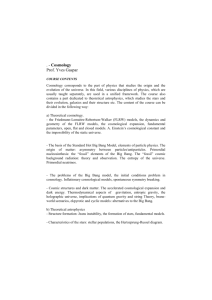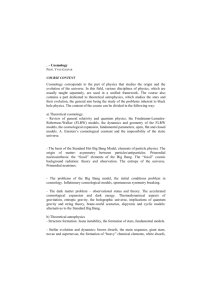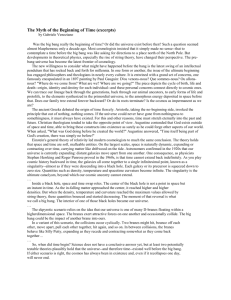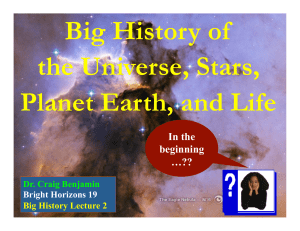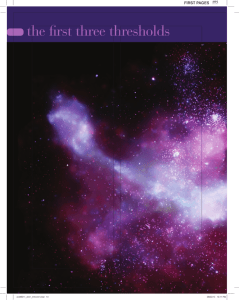Natural Science I: Quarks to Cosmos MAP
advertisement
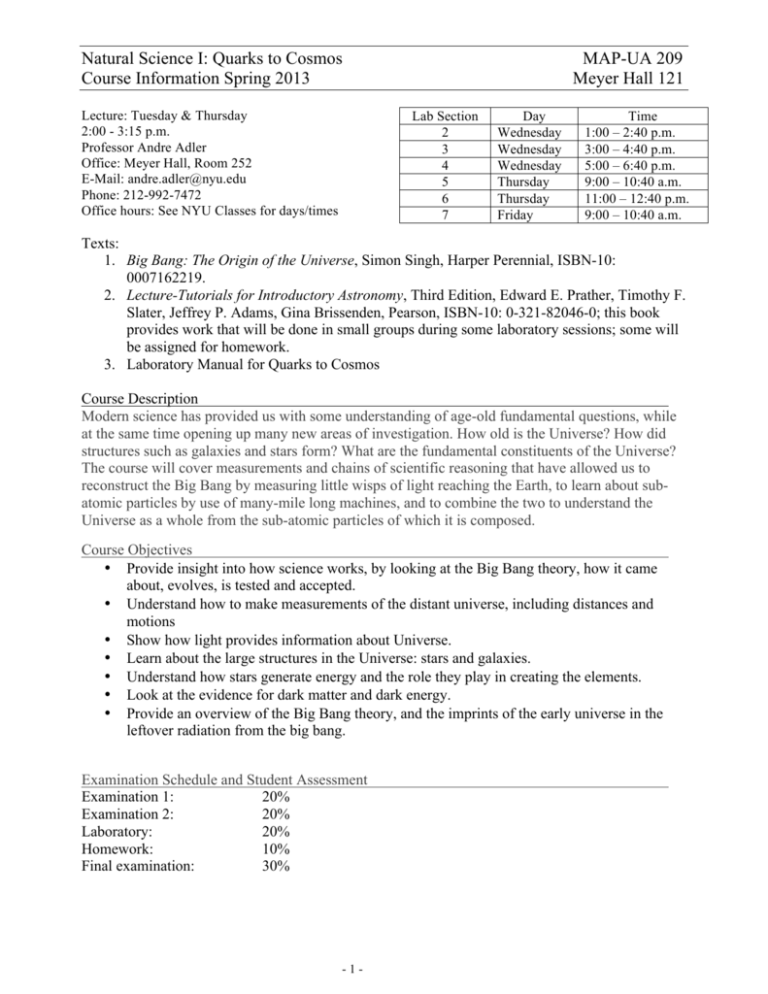
Natural Science I: Quarks to Cosmos Course Information Spring 2013 Lecture: Tuesday & Thursday 2:00 - 3:15 p.m. Professor Andre Adler Office: Meyer Hall, Room 252 E-Mail: andre.adler@nyu.edu Phone: 212-992-7472 Office hours: See NYU Classes for days/times MAP-UA 209 Meyer Hall 121 Lab Section 2 3 4 5 6 7 Day Wednesday Wednesday Wednesday Thursday Thursday Friday Time 1:00 – 2:40 p.m. 3:00 – 4:40 p.m. 5:00 – 6:40 p.m. 9:00 – 10:40 a.m. 11:00 – 12:40 p.m. 9:00 – 10:40 a.m. Texts: 1. Big Bang: The Origin of the Universe, Simon Singh, Harper Perennial, ISBN-10: 0007162219. 2. Lecture-Tutorials for Introductory Astronomy, Third Edition, Edward E. Prather, Timothy F. Slater, Jeffrey P. Adams, Gina Brissenden, Pearson, ISBN-10: 0-321-82046-0; this book provides work that will be done in small groups during some laboratory sessions; some will be assigned for homework. 3. Laboratory Manual for Quarks to Cosmos Course Description Modern science has provided us with some understanding of age-old fundamental questions, while at the same time opening up many new areas of investigation. How old is the Universe? How did structures such as galaxies and stars form? What are the fundamental constituents of the Universe? The course will cover measurements and chains of scientific reasoning that have allowed us to reconstruct the Big Bang by measuring little wisps of light reaching the Earth, to learn about subatomic particles by use of many-mile long machines, and to combine the two to understand the Universe as a whole from the sub-atomic particles of which it is composed. Course Objectives • Provide insight into how science works, by looking at the Big Bang theory, how it came about, evolves, is tested and accepted. • Understand how to make measurements of the distant universe, including distances and motions • Show how light provides information about Universe. • Learn about the large structures in the Universe: stars and galaxies. • Understand how stars generate energy and the role they play in creating the elements. • Look at the evidence for dark matter and dark energy. • Provide an overview of the Big Bang theory, and the imprints of the early universe in the leftover radiation from the big bang. Examination Schedule and Student Assessment Examination 1: 20% Examination 2: 20% Laboratory: 20% Homework: 10% Final examination: 30% -1- Lecture-Tutorials This book consists of over 40 tutorials. Some will be used in certain laboratory sessions and some will be assigned for homework. There is space for answering each question and the pages are perforated. There is space after each question to write your answer. In the laboratory, you will work with a fellow student and it is recommended you do the same for the homework. Completed work will be removed from the book and, after you write your name on it and staple the pages together, turned in for grading. Assigned work will not be accepted if answers are not written in the assigned spaces in the book. Laboratory Sessions These weekly sessions are an important part of the course. You must be registered for one lab section. You will have to submit a lab report for each experiment performed. The lab report has to include answers to all questions and any data you may have collected. Most lab reports can be completed within the lab period, however you will have no more than a week to submit the final report if you cannot do so in the lab session. The laboratory sessions will be held in Meyer 161 and will begin the week of February 4. A number of lab sessions will require you bring your copy of the Lecture-Tutorials volume. Pages are perforated and completed work will be removed from the book and submitted to your lab instructor. Attendance The lab instructor will deduct points from your lab grade for arriving late or leaving early. Absence Policy Excused absences will only be given in the case of illness (with a doctor’s note) or observation of a religious holiday. You must notify your lab instructor in advance in writing if you miss a lab due to religious reasons. All other absences will be considered unexcused and will result in a lab grade of zero. You cannot make up a lab by attending a laboratory session that you are not registered for. Late Assignments Late assignments will be penalized for each day late (excluding weekends). If you wish to submit a late lab report you must do so only at your laboratory instructor’s office. Lab Instructors Each lab instructor will hold a weekly office hour where you can discuss lecture and laboratory material. Office locations and office hour schedule will be announced in lab. Exams There are three exams: all are closed book and in multiple-choice format. The exams must be taken at the scheduled times unless you are registered with The Center for Students with Disabilities. In that case, you must present your professor with the appropriate form at least one week in advance of the exam. You will need a non-programmable, non-graphing calculator (that does not also function as a communication device). Please check your calculator before the exam to see that it works. Important formulas constants will be given. In the event of illness, or other accepted excuse, make up examinations will be provided, but the format will not necessarily be multiple-choice. -2- In the table below, LT stands for Lecture-Tutorials for Introductory Astronomy Week Jan. 28 Weekly Class Topics Measuring the Sizes and Distances between the Earth, Moon and Sun Earth-Centered Model, Heliocentric Model, Retrograde Motion Lab Schedule No Lab Feb. 4 Copernicus’ Sun-Centered Model and Galileo’s Observations of the Solar System; Tycho Brahe’s Observations and Kepler’s Three Laws Lecture-Tutorials Feb. 11 Kepler’s Three Laws Newton’s Laws of Motion and Theory of Gravity Lecture-Tutorials Feb. 18 Finite Speed of Light; The Ether; Michelson-Morley Experiment Time and Space without Gravity: Special Relativity Feb. 25 February 26, Examination 1 General Relativity (GR): Einstein’s Theory of Gravity Mar. 4 Einstein Applies GR to Cosmology with the Cosmological Constant Friedmann and Lemaitre apply GR Cosmology without the Cosmological Constant Mar. 11 Emergence of Telescopes: Herschel, the Milky Way and the Spiral Nebulae Goodricke, Leavitt and Variable Stars: Binary Stars and Cepheid Variables Mar. 18 Spring recess Mar. 25 Spectroscopy The Doppler Effect and Hubble’s Law Preparation for Exam 1/Practice Exam 1 for Extra Credit Lecture-Tutorials Principle of Equivalence & Lecture-Tutorials Lecture-Tutorials No Lab Preparation for Exam 2/ Practice Exam 2 for Extra Credit Apr. 1 Atomic Structure and Nuclear Fusion: How Stars Shine Gamow, Alpher and Herman’s Model of the Early Universe: Successes and Failures Hubble’s Law & Lecture-Tutorials Apr. 8 April 9, Examination 2 Cosmic Microwave Background (CMB) Radiation Inverse Square Law Apr. 15 Hoyle, Gold and Bondi: The Steady State Model of the Universe Cosmology Debates the Big Bang vs. Steady State Models of the Universe Young’s Experiment Apr. 22 Radio Astronomy and it’s Impact on the Cosmology Debate Penzias and Wilson: Discovery of the CMB Apr. 29 COBE Satellite Detects Fluctuations in the CMB Dark Matter: Cold Dark Matter vs. Hot Dark Matter May 6 Particle Physics in the Early Universe Dark Energy May 21 Spectroscopy Lecture-Tutorials Preparation for Final Exam/ Practice Final Exam for Extra Credit Final Exam 2:00 to 3:50 pm -3-

